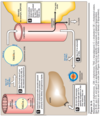3 - Cholesterol Flashcards
1
Q
- Where in the human body is cholesterol synthesized? Which tissues produce the most cholesterol?
A
- Cholesterol is synthesized by virtually all tissues in humans.
- Liver, intestine, adrenal cortex, and reproductive tissues, including ovaries, testes, and placenta, make the largest contributions to the body’s cholesterol pool.
2
Q
Major sources of liver cholesterol
A

3
Q
- Where in the cell is cholesterol manufactured?
A
- Synthesis requires enzymes in both the cytosol and the membrane of the smooth ER.
4
Q
Which step in the synthesis of cholesterol is the rate-limiting one? What is the enzyme catalyzing this step? What four specific mechanisms serve to regulate this enzyme?
A
- Which step in the synthesis of cholesterol is the rate-limiting one?
- The reduction of HMG CoA to mevalonate → rate-limiting
- What is the enzyme catalyzing this step?
- Catalyzed by HMG CoA reductase in cytosol using two molecules of NADPH and releasing CoA (irreversible)
- What four specific mechanisms serve to regulate this enzyme?
- Sterol-dependent regulation of gene expression
- Sterol-accelerated enzyme degradation
- Sterol-independent phosphorylation/dephosphorylation
- Hormonal regulation
- (Inhibition by drugs)

5
Q
Sterol-dependent regulation of HMG CoA reductase
A
- Controlled by the transcription factor, SREBP-2 (sterol regulatory element-binding protein-2) that binds sterol regulatory element (SRE) of the reductase gene.
- SREBP is an integral protein of the ER membrane, and associates with a second ER membrane protein, SCAP (SREBP cleavage–activating protein).
- When sterol levels in the cell are low, the SREBP-SCAP complex is sent out of the ER to the Golgi. In the Golgi, SREBP is sequentially acted upon by two proteases, which generate a soluble fragment that enters the nucleus, binds the SRE.
- This results in increased synthesis of HMG CoA reductase and, therefore, increased cholesterol synthesis
- If sterols are abundant, SCAP-SREBP complex in the ER is retained thus prevent the activation of SREBP

6
Q
Sterol-accelerated HMG CoA reductase degradation
A
- The reductase itself is a sterol-sensing integral protein of the ER membrane. When sterol levels in the cell are high, the reductase binds to insig proteins. Binding leads to ubiquitination and proteasomal degradation of the reductase
7
Q
Sterol-independent phosphorylation/dephosphorylation of HMG CoA reductase
A
- Reductase activity is controlled covalently by adenosine monophosphate-activated protein kinase (AMPK) and a phosphoprotein phosphatase. Phosphorylated form of the enzyme is inactive, whereas the dephosphorylated form is active.
- AMPK is activated by AMP, so cholesterol synthesis is decreased when ATP availability is decreased.
8
Q
Hormonal regulation of HMG CoA reductase
A
- Increase in insulin and thyroxine up-regulates the expression of the gene for HMG CoA reductase whereas glucagon and glucocorticoids have the opposite effect
9
Q
- Discuss the essence of statins. What are they and what do they do?
A
- The statin drugs are structural analogs of HMG CoA, and are (or are metabolized to) reversible, competitive inhibitors of HMG CoA reductase; used to decrease plasma cholesterol levels in patients with hypercholesterolemia.

10
Q
- Can cholesterol be degraded in the human body?
A
- The ring structure of cholesterol cannot be metabolized to CO2 and H2O in humans.
11
Q
- How is cholesterol eliminated from the human body?
A
- The intact sterol nucleus is eliminated from the body by conversion to bile acids and bile salts, which are excreted in the feces, and by secretion of cholesterol into the bile, which transports it to the intestine for elimination. Some cholesterol in the intestine is modified by bacteria into isomers coprostanol and cholestanol before excretion.
12
Q
- What are the two most important organic components of bile?
A
- Phosphatidylcholine (lecithin) and bile salts (conjugated bile acids)
13
Q
- Which enzyme carries out the rate-limiting step in bile acid synthesis? Where is this enzyme found and why? What down-regulates this enzyme?
A
- Which enzyme carries out the rate-limiting step in bile acid synthesis?
- Cholesterol-7-α-hydroxylase
- Where is this enzyme found and why?
- It is an ER-associated cytochrome P450 (CYP) enzyme found only in liver.
- What down-regulates this enzyme?
- Down-regulated by cholic acid
14
Q
- What is a bile salt? What is the function of bile salts?
A
- Bile salt is a conjugated form of bile acid with an addition of either glycine (resulting in lower pKa) or taurine (resulting in sulfonate group); both forms are fully ionized (i.e. negatively charged) at physiologic pH.
- Bile salts are more effective detergents than bile acids because of their enhanced amphipathic nature; this is also why only the bile salts are found in the bile.
15
Q
- What action do intestinal bacteria have on primary bile acids?
A
- Bacteria in the intestine can remove glycine and taurine from bile salts, regenerating bile acid.
- They can also convert some of the primary bile acids into “secondary” bile acids by removing a hydroxyl group, producing deoxycholic acid from cholic acid and lithocholic acid from chenodeoxycholic acid






